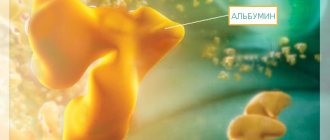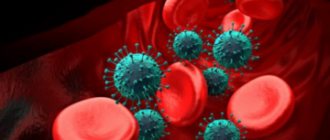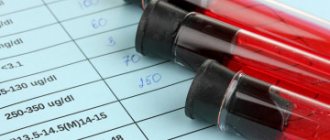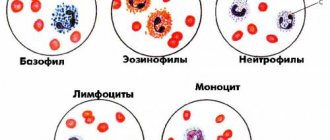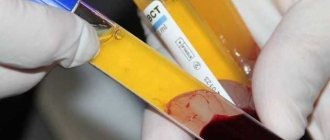What does AST blood mean?
Aspartate aminotransferase (AST, AST, AST) is one of the enzymes of protein metabolism, which is responsible for the synthesis of amino acids necessary for the cells of the myocardium, liver, and skeletal muscles. The essence is maintaining a high level of metabolic processes in these internal organs and tissues.
As long as the cellular structure containing AST is intact, the amount of enzyme in the bloodstream is minimal. When the integrity of the cells is violated, AST is released into the bloodstream, and an increase in the level of the enzyme is recorded, directly proportional to cytolysis. In this process, a major role is played by the time of cellular decay: the longer it is, the less AST activity in the blood plasma.
AST norms for men, women and children
Knowing the normal enzyme values is necessary to correctly assess the enzymatic activity of AST in plasma. They focus on reference indicators, since different laboratories use not only different reagents, but also determination methods. Commonly accepted ACT gender norms are presented in the table.
| Method of determination | Norm |
| In men | |
| Optic | From 39 to 42 IU |
| Reitman-Frenkel reactions | 0.15 to 0.5 µmol |
| Among women | |
| Optic | From 33 to 36 IU |
| Reitman-Frenkel reactions | 0.12 to 0.4 µmol |
| In children | |
| Optic | Up to 51 IU |
| Reitman-Frenkel reactions | From 0.25 to 0.51 µmol |
If biochemistry gives values that do not exceed normal blood AST values, then the enzyme systems of the liver and heart are intact and functioning normally. If there is a clinic, it is necessary to study other markers: ALT, troponins, creatine phosphokinase, and so on.
AST blood test is elevated, what does this mean?
An increase in AST indicates cytolysis (cellular destruction) of varying severity. Especially if the growth of AST can be traced over time, that is, the increase is not one-time (random). An increase in enzyme levels is possible when:
- debut of AMI (the indicator makes it possible to judge the area of myocardial damage);
- heart muscle injuries;
- myocarditis, including autoimmune etiology;
- viral hepatitis (acute or chronic);
- toxic liver damage, including medications;
- fatty or alcoholic hepatosis;
- infectious and toxic processes in internal organs and soft tissues (suppuration, sepsis);
- CHF;
- GSD, liver duct tumors with or without metastases, anomalies in the development of bile ducts with cholestasis;
- portal hypertension;
- liver cirrhosis;
- myeloblastic leukemia;
- myodystrophy, severe myositis, reperfusion, crash syndrome, muscle ischemia and other forms of muscle cytolysis.
A sign of cellular cytolysis is considered to be an increase in AST more than twice the normal level. Therefore, not every increase in AST is regarded as a pathological condition. We can talk about three degrees of diagnostically important increase in the AST indicator:
- moderate – increase in AST by 5 times;
- on average – an increase in AST up to 10 times;
- severe – exceeding the norm by more than 10 times compared to the norm.
This is especially valuable if AMI is suspected. Detection of an upward trend is a reason for a blood test every hour: any doubts are interpreted in favor of a heart attack.
Why do enzyme levels change?
If AST in the blood is slightly increased (about 5 times), then this may be due to fatty hepatosis, taking certain medications (barbiturates, statins, antibiotics, drugs, chemotherapy drugs, etc.).
A moderate, average increase in the enzyme (up to ten times higher than normal) can be caused by chronic liver diseases, cirrhosis, myocardial infarction, myocardiostrophy, processes occurring with damage to kidney and lung cells, mononucleosis, cancer.
If AST in the blood is greatly increased (10 times or more), this tells the doctor that the patient may have viral hepatitis in the acute stage, toxic damage to the liver structures, drug-induced hepatitis (acute), and this may also indicate a leak in the body processes accompanied by tissue necrosis (for example, with tumors).
At the beginning of the disease, in its acute stage, when the process of tissue destruction is fastest, the highest level of aspartate aminotransferase is observed. A decrease in AST in the blood serum means the beginning of restoration processes in organ cells and the patient’s recovery. Slight excesses of the norm are not a sign of tissue destruction.
There are quite a few reasons for the decrease and increase in ALT and AST in the blood, but there are certain criteria that help the doctor figure out which organ is affected and find out the main characteristics of the developing pathology.
An increased level of an enzyme is considered to be one that exceeds normal levels by tens or hundreds of times. The reasons for an increase in ALT by 20 times or more is the acute form of hepatitis A, B and C. With hepatitis of an alcoholic nature, the concentration of the enzyme increases approximately 6 times, and with the development of fatty liver, the indicator exceeds the norm by 2-3 times.
But with neoplasms, the increase in the coefficient is often insignificant, but even this cannot be left without due attention. In addition, the indicator may increase with the following pathologies or conditions:
- dysfunction of the hematopoietic system;
- uncontrolled use of dietary supplements;
- burns of large surfaces of the body;
- excessive physical activity;
- acute form of pancreatitis;
- viral infections;
- poor nutrition;
- state of shock;
- muscular dystrophy;
- mononucleosis.
ALT levels may be affected by taking oral contraceptives, choleretics, psychotropic and antitumor drugs, steroids, immunosuppressants, etc. Therefore, before taking tests, you should warn your doctor about the use of any of these medications.
A decrease in enzyme concentration indicates the development of severe pathologies, such as cirrhosis and necrosis, or may be the result of liver rupture. Another reason that can reduce ALT levels is vitamin B6 deficiency, as well as taking medications that include interferon, aspirin, and phenothiazine.
Common causes of increased ALT concentrations
When tissues are renewed with the parallel death of obsolete cells or when they are destroyed in an unnatural way, AST leaves the dead structures and enters the bloodstream. This causes a noticeable increase in the enzyme, and its concentration can increase 20 times relative to normal levels. An increase in AST is observed with dysfunction of the following organs.
Heart:
- Myocardial infarction (the level increases up to 10-20 times), and biochemical analysis makes it possible to determine the occurrence of the disease before its symptoms appear on the ECG.
- Acute coronary insufficiency (the patient experiences an increase in values throughout the day, and then they decrease, and after a few days they return to normal).
- Status after cardiac surgery, catheterization of cardiac vessels (angiocardiography).
- Pulmonary artery thrombosis, severe attacks of angina, acute rheumatic carditis, tachyarrhythmia.
Liver and gallbladder:
- hepatitis of various nature (alcoholic, viral, toxic);
- cirrhosis, amoeba infections;
- hepatocellular carcinoma (malignant tumor of the liver);
- cholestasis (blockage of the bile ducts);
- cholangitis (inflammatory process in the bile ducts).
Pancreas:
- acute pancreatitis;
- phlegmon of the retroperitoneal tissue.
Skeletal muscles:
- muscle injuries of various origins;
- dystrophy of muscle structures.
Reference! If aspartate aminotransferase is elevated and its level does not fall within 3–5 days, this indicates a critical condition of the patient. A further increase in the enzyme content indicates an increase in the necrotic focus or the involvement of nearby tissues in the process.
At the same time, in people suffering from angina pectoris, as well as late stage cirrhosis, as a rule, the AST level does not go beyond the normal range. An increase in the enzyme can sometimes be observed in a healthy person.
This can occur after drinking alcohol, muscular exercise, or a certain number of medications. In children, the activity of the described enzyme sometimes increases with the development of inflammatory processes. In addition, an increase in AST is often observed during pregnancy.
Decline in AST indicator
This ratio can be reduced by the development of severe necrotic processes in the liver, a lack of vitamin B6, or repeated dialysis. If the rupture of the liver parenchyma is accompanied by a decrease in both of the described enzymes, and bilirubin increases or does not leave the normal range, then this means a high probability of an unfavorable prognosis.
Indications for the study
Determination of the AST activity indicator is included in the international diagnostic standard and is mandatory for many types of somatic pathology. For example, diseases of the heart and blood vessels, liver pathology of any origin, toxic lesions, poisoning. This also includes: infections, renal failure, suppuration, sepsis.
A biochemical blood test for AST is recommended for disorders of bilirubin metabolism, portal hypertension, ascites, encephalopathy of unknown origin, and autoimmune processes in the body. The level of the enzyme is determined in acute pathology of the abdominal organs, obstruction of the bile ducts of any etiology, damage to the pancreas, other endocrine disorders, allergic dermatoses.
A necessary study is to determine AST in the blood, if there are symptoms of tumor growth in the body, treatment is carried out with cytostatics, antibiotics, and chemotherapy. AST is mandatory before preparing for surgery and to assess the effectiveness of treatment.
Diet and prevention
What is the prevention of such abnormalities in blood test results? Of course, first of all, it is necessary to prevent the occurrence of pathologies and diseases that provoke an increase or decrease in the level of enzymes in the human body. Of course, there must be a renunciation of bad habits, drinking alcoholic beverages, some strong and/or illegal drugs, and smoking.
When it is necessary to reduce the level of enzymes in the blood, a reasonable diet should be used along with taking medications prescribed by the doctor and auxiliary folk remedies.
In case of liver-related pathologies, it is recommended to completely avoid alcohol, fried in oil and fatty, smoked and overly salty and sweet foods. The patient's diet should consist of the right combination of proteins, fats and carbohydrates; poultry and lean meat, as well as fish, vegetables and cereals can be eaten. And everything needs to be cooked by steaming or stewing without adding oil.
Preparing and conducting analysis
Biochemistry includes, among other things, quantitative analysis of plasma AST activity. The analysis requires venous blood (about 20 ml). It is taken on an empty stomach and centrifuged, which allows you to separate the plasma from the formed elements. Subsequent biochemical reactions with various reagents determine the activity of AST, the degree of cytolysis in the liver and heart muscle. This is important not only for direct diagnosis of the pathological process, but also for differential diagnosis or exclusion of cardiac and hepatic pathology. Results are usually ready the next day. Decoding is the prerogative of the doctor.
To obtain reliable results, you should follow simple rules:
- last meal – 8 hours before the test;
- per day - abstain from alcohol, fatty, spicy, salty foods;
- on the eve of the analysis, you need to avoid stress, psycho-emotional, and physical stress;
- Before the analysis, you should not drink tea, coffee, juice - only clean water.
The intake of medications is coordinated with the doctor, and he is also warned about the presence of allergies. You cannot donate blood for AST within several hours after FLG, X-ray, physiotherapy, ultrasound, or rectal examinations.
How to prepare
To minimize the risk of distortion of test results, the patient must properly prepare for blood sampling:
- Biological material must be donated before the morning meal, so you should visit the laboratory immediately after waking up.
- Before visiting the laboratory, you can have your last meal no later than 8 hours before.
- In 1 day. Before collecting biological material, the patient must stop drinking alcoholic beverages. You should also completely abandon the consumption of smoked and other harmful foods, and eliminate psycho-emotional overload.
- On the day of the test, a person can drink a glass of water. It is strictly forbidden to drink coffee, teas or juices before taking blood, as their components can adversely affect the results.
- Patients are recommended 1 week in advance. Before collecting biological material, stop using medications, except for life-saving drugs (you should tell the laboratory assistant about this).
- The person should not smoke on the day of the test. If he cannot give up his addiction, then the last cigarette should be smoked no later than an hour before the collection of biological material.
What influences test results?
The AST level is of diagnostic value when the growth is two times or more compared to the norm. This means that special attention should be paid to all points that in one way or another can affect the result of the analysis. Among them:
- taking medications, even such as herbal tinctures of echinacea and valerian;
- excessive doses of vitamin A;
- catheterization;
- surgical interventions, especially on the heart;
- the flowering period of herbs for allergy sufferers and menstruation (pregnancy) for women.
